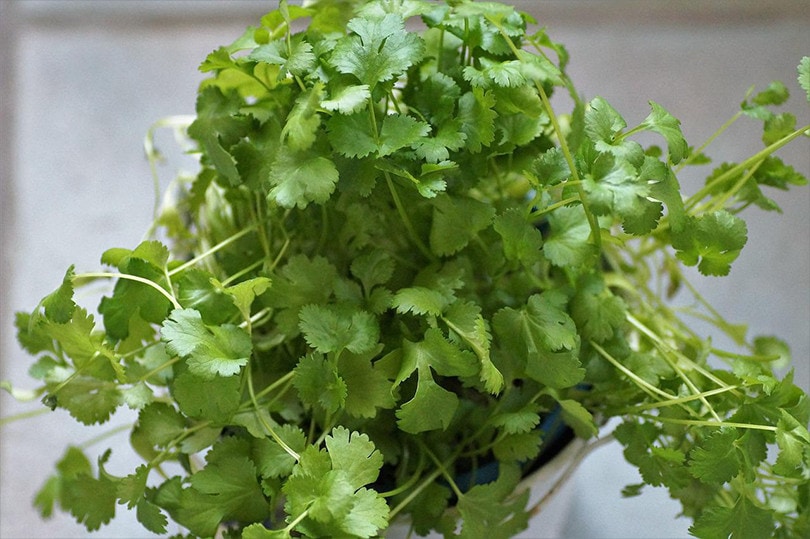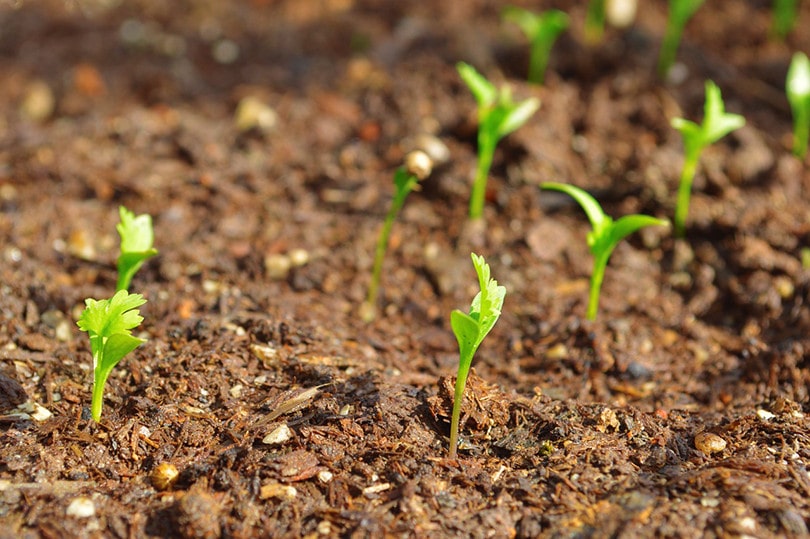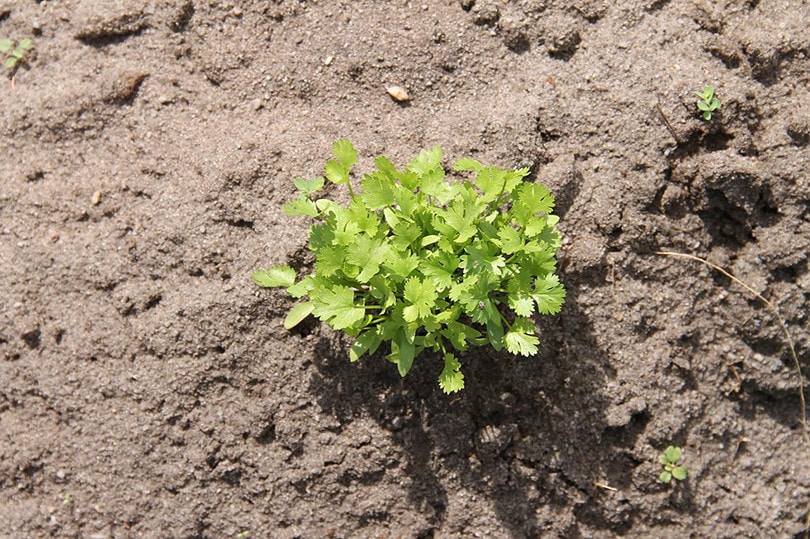Can You Grow Cilantro Indoors? Tips, Tricks, and How to Guide
-
Kristin Hitchcock
- Last updated:

Cilantro has been successfully grown indoors as both a full-sized plant and a microgreen. If you enjoy cilantro, growing some inside makes it easy to add the fresh herb to your meals while cooking. (Of course, if cilantro tastes like soap1, you’re probably in the wrong article!).
However, the main difficulty is that cilantro requires full sun. In other words, it needs direct sunlight for at least 6 hours a day. Therefore, it will need to be placed near a very sunny window or under supplemental lighting. Luckily, it does prefer room temperature, so you don’t have to worry about adjusting the temperature of your home.
You’ll need well-draining potting soil, but this plant usually prefers moist soil. You’ll need to water it regularly and baby it a little bit. However, if you pay attention to it, cilantro isn’t terribly difficult to grow indoors.
Collecting All the Supplies

Before you plan your cilantro, it is vital that you have all of the supplies already collected. Starting on the right foot can make your life much easier, so we highly recommend taking your time to select the correct soil and pots.
Pot
Because you’re growing indoors, you’ll probably want a pot that looks nice. However, we do recommend a glazed clay or plastic pot, as they tend to keep the soil moister than terra cotta. Of course, the container should have drainage holes at the bottom for excess water to drain. Consider this when you’re watering your plant as well since you don’t want water all over your countertop.
If you’re growing full-sized plants, you’ll want a pot that is:
- Deep rather than long
- At least 8-inches in diameter for a single plant
- At least 12-inches in diameter for three plants
If you’re growing microgreen cilantro, choose a pot that is:
- Shallow and wide (a bit like a tray)
- Around 10-inches x 20-inches
Soil (Or Other Growing Media)

Now that you have a pot, you’ll need to purchase the soil to place in the pot. While most people do use potting soil for indoor plants, you do have some other options as well. Cilantro isn’t very picky about what material you use, as long as it drains well. We recommend a medium that holds water since cilantro prefers moist soil.
Here are your options:
- Commercial potting mix: Despite some common misconceptions, potting mixes don’t actually contain “soil”. Instead, they are a mix of peat moss, coconut coir, pine bark, and a variety of other materials.
- Coconut coir: While coconut coir is commonly used in potting mixes, you can also purchase it by itself. It is made from the fibers found in the coconut, making it a renewable material.
Location
Next, you’ll need to choose a location to put your cilantro. As a sun-loving plant, somewhere by a window is a must. We recommend an unobstructed south-facing window for maximum sun exposure. If this isn’t possible, you’ll need to consider using a bright grow light.
Be sure to purchase one that is a broad-spectrum LED, HID, or fluorescent grow light. Your usual light bulb won’t do.
Top 5 Tips on Growing Cilantro
1. Plant the Seeds
If you’re starting the plants from seeds, now is the time to plant them. To help them germinate a bit faster, place the seeds in a small bowl and then cover them with cool water. Wait for 24 hours and then drain the seeds. Plant them into the potting mixture in your chosen pot before they dry out.
We recommend pre-moistening the potting soil to make it easier to work with. Otherwise, it may be dry and crumbly. Gently press on the soil to remove any air pockets. Then, plant the seeds about ¼ of an inch into the soil. Place three seeds in a triangle at the center of each pot. Not all the seeds will germinate.
When the seedlings produce their second set of leaves, you’ll need to thin them out by removing the weaker plants. You can use the weaker plants as a seasoning just like you would the adult leaves.
2. Start from a Seed Cutting
Alternatively, you can start cilantro from a seed cutting. This method only works for full-size plants. First, take a 4-inch cutting from a grown plant right below a node. Remove all of the leaves from the bottom 2-inches of the stem.
Next, place the end of the stem in a glass of water. It should start generating roots within a few days. Let the roots grow to a couple of inches long. Then, carefully place the new plant in the substrate of your choice. Pre-moisten it to make it easier to work with.
3. Ensure the Correct Growing Conditions
Now that your plant is planted, your only job is to ensure that the correct growing conditions remain. You’ll want the plant to stay in a warm location that is at least 70-degrees—at least until the plant appears to be thriving. You do not want the temperature to read above 85-degrees, though, as this can cause the plant to bolt.
Keep the soil moist by watering it every day. For smaller plants, use a spray bottle to avoid displacing them. Overwater instead of underwater. When in doubt, place the plant in the sink and water until the pot begins to drain. If you have a well-draining pot, you really can’t overwater cilantro.

4. Fertilize As Necessary
As your plant continues to grow, you may need to add some fertilizers. For this purpose, you can use a general liquid plant food. Follow the directions carefully when using this fertilizer. Each liquid plant food is slightly different, so always check the directions before use.
You’ll likely need to fertilize about once a week for the best effect. However, you should follow the manufacturer’s instructions.
5. Harvest
Now that your plant is grown, it is time to harvest it. You can technically harvest leaves whenever you want to. However, you will need to start harvesting at about 5 to 7 weeks. Otherwise, your plant may get leggy.
If you want the plant to continue growing, lightly cut back the outermost leaves when they reach about 5 inches long. Do this every time, even if you do not plan on using the leaves. Alternatively, you can harvest the whole plant at a time.
Related Read: Can You Grow Rosemary Indoors? Tips, Tricks, and How-to Guide
 Conclusion
Conclusion
The hardest part of growing cilantro is ensuring that it has enough sunlight. However, after you do this, everything else is pretty straightforward and easy. You only need to water it every few days and remove leaves as you use them. Most people get far more than they actually need from a single plant. Therefore, you may find yourself with excess fresh cilantro.
Theoretically, you can let your plant grow forever. It should continue to thrive and produce fresh leaves for you to use in your cooking. However, practically, many plants perish at some point. Still, with the right condition, a single cilantro plant should last for many years.
Don’t be afraid to harvest off of your plant, as this helps it grow. If your plant gets too large, it may not thrive well in a pot. Therefore, be sure to pull off the larger leaves from the outmost part of the plant when possible.
Featured Image Credit: marsraw, Pixabay
Contents

